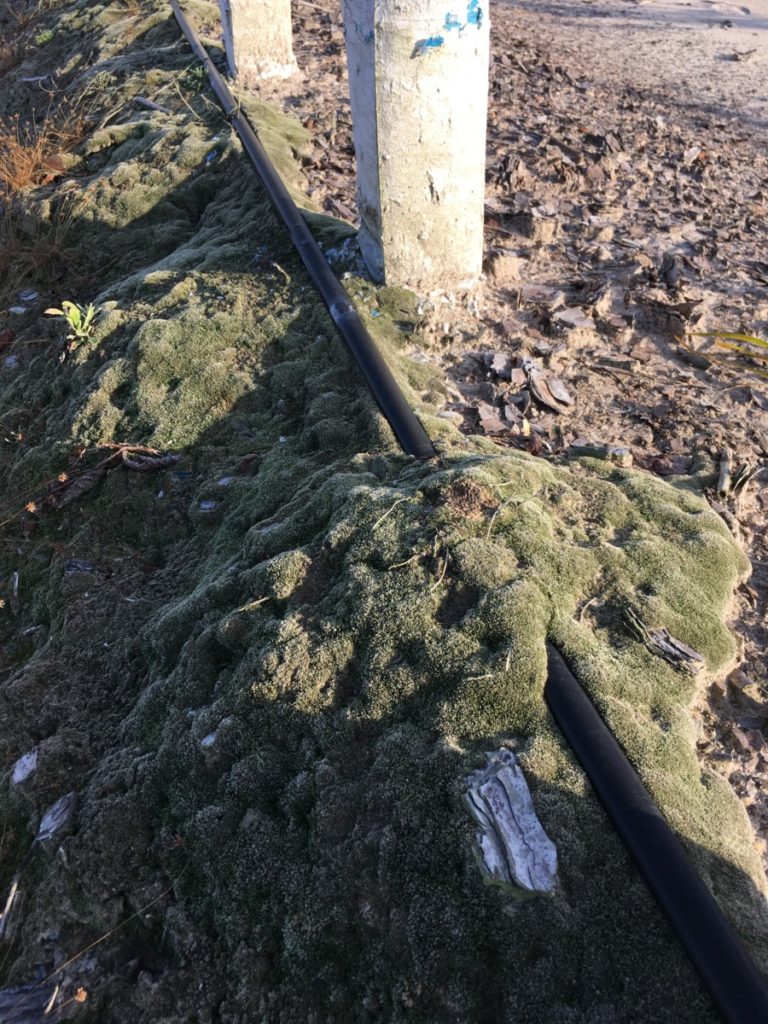It has been almost 30 days since we have had appreciable rainfall across much of the blueberry growing region in southern Georgia. While most locations in the southern half of the state are not technically in a “drought” (see https://droughtmonitor.unl.edu/), it has certainly been dry for the past month. (At my house in Tifton, for example, we have not had any rainfall since September 11th, and the last measurable rainfalls in Alma, Baxley, and Homerville date to around that time as well). Despite these dry conditions, we’ve received several reports in recent days of blueberries suffering from symptoms typical of root rots (leaf yellowing and defoliation, marginal leaf burn, stunting and poor growth), and the UGA Plant Disease Clinic in Athens has diagnosed Phytophthora on several blueberry root samples over the past two weeks. As a result, I’ve received several questions regarding why we are seeing issues with root rots at this point in the growing season, especially root rots caused by Phytophthora, a pathogen commonly associated with wet conditions.
It is certainly true that spread of and infection with Phytophthora cinnamomi, the pathogen that causes Phytophthora root rot on blueberry, is frequently associated with wet conditions. This pathogen relies on free water to survive and reproduce. The pathogen produces spores (called zoospores) which are capable of moving through water by “swimming” using their whip-like appendages (flagella), and saturated soils provide ideal locations for P. cinnamomi to spread, infect, and thrive. As such, issues with Phytophthora root rot are typically first identified in low-lying or poorly drained areas of the field.
But, given the importance of wet conditions for Phytophthora, how is it that we are seeing issues with Phytophthora root rot right now, when the weather has been so dry for the past month? I think there are likely at least two possible reasons why we are seeing these issues now in particular:
One possible reason involves the reliance on irrigation systems to provide moisture for plants in dry conditions. Even though there hasn’t been water falling out of the sky in the form of rainfall during the past month this does not mean that the soil near the base of the plants has not been saturated via drip irrigation. In fact, it can be very easy to keep the soil near the base of the plant OVERsaturated with drip irrigation, and I frequently visit blueberry sites in southern Georgia that show signs of overirrigation. (Some classic signs of overirrigation or oversaturated beds include water standing in the row middles in the absence of rainfall and moss growing on the surface of the bed or around the drip line [See Figure 1].) Previous research on blueberries in Oregon has confirmed that the use of drip irrigation can maintain high soil water near the base of blueberry bushes and result in conditions that are favorable for Phytophthora root rot (Bryla and Linderman 2007)1.

Another possible reason for the issues we are seeing with Phytophthora right now involves how root rot affects the plant. As the name indicates, Phytophthora root rot causes the roots to rot. As a result, plants affected by root rot have a reduced root system. This reduced root system may not be able to supply the plant with enough water and nutrients, especially under drought conditions. Accordingly, it may be that the dry conditions (and drought stress) we have experienced over the past month have simply allowed previous root damage caused by Phytophthora to become more obvious. Essentially, due to the recent dry spell, we may just now be seeing the effects of root rot infections that occurred over the summer, when wet conditions were present.
Control measures for Phytophthora root rot are generally limited to use of chemical fungicides; however, it should be noted that treatment with fungicides is not effective for reversing root rot damage on plants with severe symptoms. A couple of different types of products are available for control of Phytophthora in blueberries. Ridomil Gold SL contains a systemic compound, and root uptake is critical to activity. See the label for application instructions, but this material is applied for root uptake. Aliette, ProPhyt, AgriFos, K-phite, Reliant and other phosphonates are also registered systemic materials for use against Phytophthora root rots. These phosphonate products have systemic activity when foliar applied, and this systemic activity will suppress root rot. Use a sufficient volume of water for good coverage, and be aware that overconcentration of the material in the spray volume or applying too often can result in damage. Some of these phosphonates (including K-phite) can also be applied through the drip. Consult the various labels for rates, other recommendations and precautions. Additional information regarding Phytophthora root rot management can be found in the 2022 Southeast Regional Blueberry Integrated Management Guide.
1Bryla, D.R. and Linderman, R.G. 2007. Implications of Irrigation Method and Amount of Water Application on Phytophthora and Pythium Infection and Severity of Root Rot in Highbush Blueberry. HortScience. 42(6):1463–1467.